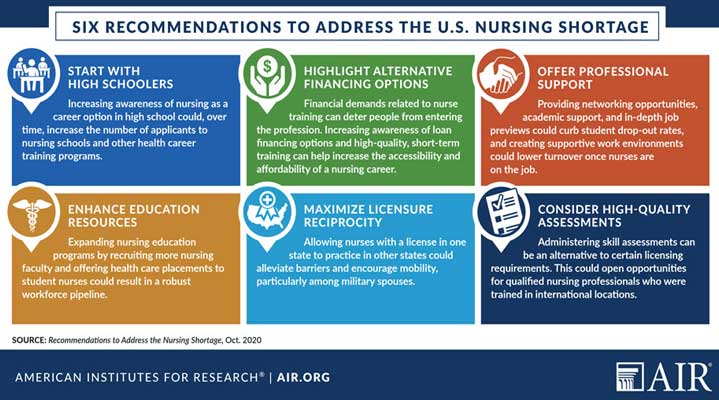The shortage of nurses has been a major concern for health care providers for years. The COVID-19 pandemic has strained healthcare systems, leaving them short-staffed and lacking resources to provide quality patient care. A recent study reveals that the global nursing shortage is expected to rise by nearly half by 2022. The U.S. nursing workforce is already facing a shortage of over 100,000 nurses, so the growing need for more health care workers is not surprising.
Global shortage of Registered Nurses
The world is facing a nursing shortage. The shortage is so severe that nearly half of the 155,000 registered nurses worldwide leave their jobs within two years. This mass exodus will only exacerbate the raging nursing labor shortage. In the United States, nursing shortages are already so bad that 35% of hospitals are reporting a critical shortage. But what can nursing students and graduates do? How can they fill the gap in the workforce?
The shortage of registered nurses will affect nearly every state. In California, for example, a shortage of 44,500 nurses will affect a surplus of just over half of the population. In Florida, the projected shortage is just over half of that number. In Georgia, the shortage will be much smaller, with 98,800 RNs available to fill the vacancies. And in Hawaii, the situation is even more optimistic. In 2030, the shortage will be only a few thousand nurses in the state.
Impact of COVID-19 pandemic on global shortage of Registered Nurses
With the COVID-19 virus pandemic threatening the health of millions of people worldwide, the Nursing and Midwifery Council has opened an emergency register for nurses from affected countries. It is a measure to address the growing global shortage of nurses. But despite the health benefits of bringing in international nurses, this practice will increase inequality in the distribution of registered nurses.
The United States has been hit particularly hard by a nursing shortage. The country’s post-industrial sector is more apparent than many other regions of the world, but the Silver Tsunami is hitting the entire country. By 2060, the number of older Americans will double to nearly 95 million. That means that older adults will outnumber children for the first time in history.
Impact of global shortage on U.S. nursing workforce
A McKinsey survey of nurses in the U.S. found that nearly 16 percent of nurses leave their jobs in their first year. The time it takes to find replacements can be as long as two to three months. Hospitals lose approximately $4 to $6 million a year because of this shortage. Moreover, nurses often change jobs, and the shortage of enough nurses lowers the quality of patient care.
Several states are facing nursing shortages. According to the National Conference on Nursing and Global Health, in 2020, there will be a shortage of approximately 18,700 nurses and a surplus of over 16,000 RNs. For instance, in 2020, the demand for nurses in Texas is projected to be 73,900, but the supply will be 83,300. In contrast, a nursing surplus of about 4,400 is projected in Wisconsin by 2030.
Essentials of Nursing Research
- Acquisitions Editor: Christina C. Burns Product Director: Jennifer K. Forestieri Development Editor: Meredith L. Brittain Production Product Manager: Marian Bellus Design Coordinator: Joan Wendt Illustration Coordinator: Jennifer Clements Manufacturing Coordinator: Karin Duf ield Prepress Vendor: Absolute Service, Inc. 9th edition Copyright 2018 © Wolters Kluwer Fifth Edition © 2011 by LIPPINCOTT WILLIAMS & WILKINS, a WOLTERS KLUWER business Fourth Edition © 2006 by LIPPINCOTT WILLIAMS & WILKINS Third Edition © 2001 by LIPPINCOTT WILLIAMS & WILKINS All rights reserved. This book is protected by copyright. No part of this book may be reproduced or transmitted in any form or by any means, including as photocopies or scanned-in or other electronic copies, or utilized by any information storage and retrieval system without written permission from the copyright owner, except for brief quotations embodied in critical articles and reviews. Materials appearing in this book prepared by individuals as part of their official duties as U.S. government employees are not covered by the above-mentioned copyright. To request permission, please contact Wolters Kluwer at Two Commerce Square, 2001 Market Street, Philadelphia, PA 19103, via email at permissions@lww.com, or via our website at lww.com (products and services). 9 8 7 6 5 4 3 2 1





